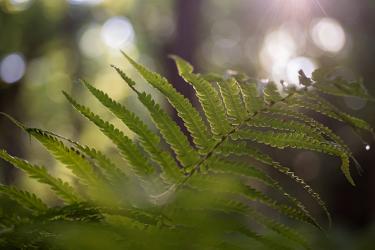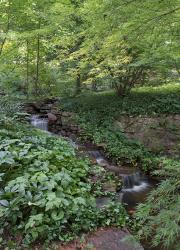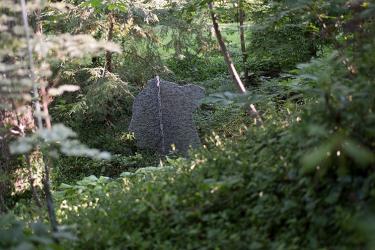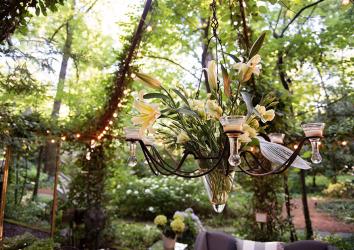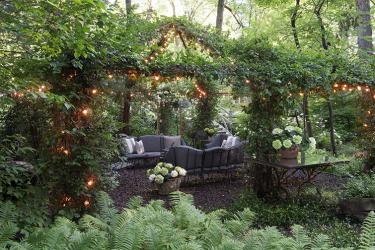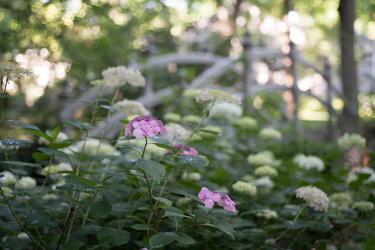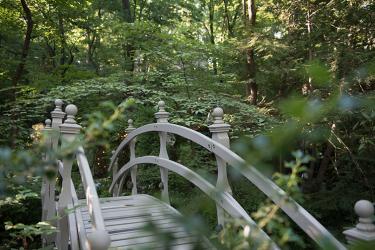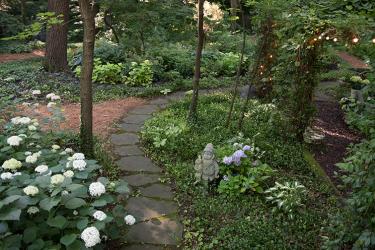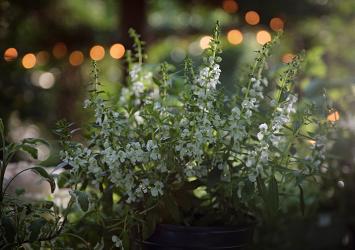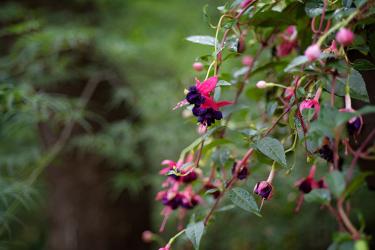“All gardeners love to share.” For this Warson Woods homeowner and custodian of an amazing, enchanted, one-of-a-kind green space, that view is firmly rooted in personal experience.
She has generously shared the garden she and her husband lovingly tend with friends as well as total strangers who have climbed its stone-step-studded hillside and strolled its mulched pathways on several public tours. “I always meet the nicest people,” she relates. “They are so interesting to talk with and I learn things from them. I always encourage people to put their homes on garden tours.”
She frankly admits that much of her knowledge has come from fellow gardeners. “I had always been interested in gardening, but several years ago I became involved with the Garden Club of America and served on committees and held positions that involved visiting a lot of gardens and taking classes. I learned so much from other gardeners who passed on their knowledge.”
While other gardeners have taught her a great deal, a bit of what has gone into creating this lush landscape has been by trial and error due to the unusual terrain. While the homeowners have lived in the residence for over 40 years, the land they garden on has changed dramatically. Over 20 years ago, a homebuilder approached a neighbor, who owned a large piece of hilly, wooded property, with an offer to buy the land, tear down the original house and build a number of new homes. Concerned as to how that would affect their home, the homeowners bought the property themselves, sold the original house and one additional lot and used the hillside lot closest to their home to erect a dramatic, glass-walled studio for the architect/artist husband. Central to their plan was to surround the studio with a beautiful woodland garden that would connect the studio and their home.
That opportunity became a dramatic reality when, while visiting friends, they admired a water feature and asked the name of the designer who created it. “His name was Mark Couch, (of Woodland Gardens, who has since passed away) and he came over one Saturday to look things over. I left him talking with my husband in the studio and two hours later my husband called me and said, ‘You’d better come up here.’” Mark’s plan was to create two streams that came from above and at the side of the studio, flowed down the hillside and joined in a koi pond at the bottom of the hill. “That was Saturday afternoon at 4 p.m. and Mark said he had just finished another project and he could start work on Monday. If we had had time to think about it, we probably wouldn’t have done it, but we just said, ‘Go for it,’” the homeowner says.
Another important part of the plan involved a place within the garden to entertain family and friends that would blend seamlessly with the woodsy surroundings. Designed by the homeowner herself, the now-vine-covered superstructure, constructed of copper piping, encompasses a relaxed seating area and a separate space for dining. While the enchanted pavilion seems to naturally spring from the forest floor and the living canopy above, finding the appropriate vines to create such an ambiance was not easy. “Just name any vine you’ve ever heard of and is on the market and we’ve tried it,” the gardener says laughing, noting that the preponderance of shade at the site of the pavilion made things more difficult. Her husband refers to the process as the “vine wars” in which the couple planted every vine they could find and “at the end you see who makes it” in a survival of the fittest process. Winners include Dutchman’s pipe, akebia, pink honeysuckle, sweet autumn clematis, trumpet vine, climbing hydrangea, euonymus and Boston ivy. While the vine blossoms are not prolific due to the shade, they do provide a succession of flowers throughout the growing season.
Coming up with the right plant material for the steep, shady setting also has required a bit of trial and error. Initially, the couple planned for azaleas to cascade down the hillside and surround the pond. The azaleas promptly died. They then tried rich, glossy-leaved laurel. The laurel wasn’t happy either.
The third time proved the charm with a massive planting of evergreen, long-blooming hellebores, which can begin flowering as early as February, giving rise to the common name Lenten rose. The flowers can last until summer and the attractive, serrated, umbrella-like foliage provides a handsome dark green, naturalizing groundcover. “We think the hillside created a micro climate and the cold settled in,” she explains, noting that the microclimate probably proved too extreme for the other shrubs.
While many hydrangeas will thrive with partial sun, the Limelights the couple tried needed more sun than the setting could provide and refused to bloom. They eventually traded that variety for reliable Annabelle hydrangeas, native to this area, whose large, white, mop-head flowers appear reliably every summer. “They have bloomed their little heads off,” she says happily, “and some of them have gotten quite tall.”
A massive field of willowy, graceful ostrich ferns adds another dimension to the garden. Rippling in the slightest breeze, they add movement and a soft texture to the shady space.
Interspersed among the shrubs, the homeowner has picked selective spots to grow shade perennials. In the spring, jack in the pulpit, Solomon’s seal, blue bells, trillium and assorted spring bulbs start the flowering. Then, as they disappear, multiple varieties of hostas, toad lily, monarda, ligularia, phlox, arum italicum, indian pinks, cleome and astilbes shine forth. With fall come the meadow rue, monkshood, cimicifuga and anemone. Surprisingly, she has found just the right spot for hardy camellias, which are currently loaded with buds. “You really have to spend a lot of time outside watching and paying attention,” she emphasizes. “There might actually be one spot that gets eight hours of sun and right next to it is a spot that gets only two hours of sun.”
The trial and error and hours spent watching the sun in order to create something beautiful are each part of the gardening process on which the homeowner thrives. “It’s my passion,” she says simply. “I love it when people say they like my garden, but that’s not why I do it. I love being in that process and in the garden.”


